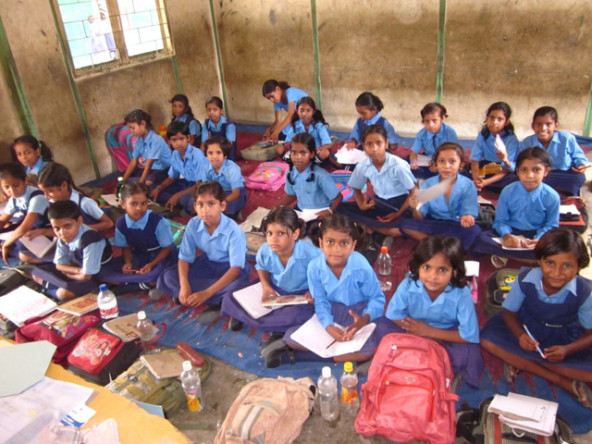In the last couple of years, India has witnessed an educational revolution. Numerous social enterprises and NGOs have sprouted up, claiming to combat educational inequity in India—basically, the lack of opportunities for a certain strata of students to realize their potential and develop their creativity. As a teacher of fourth grade in a low-income government school in New Delhi, I have had the privilege of interacting with many education entrepreneurs and educators in India, and the consensus is that inequity is one of the most important educational issues to resolve. Entrepreneurs, activists, and policy makers have been searching for concrete solutions, but few take in the complexity of the situation. Addressing inequity requires that we consider all aspects of the educational system, including curriculum development, technology, school infrastructure, and teacher training. Targeting just one of these aspects in isolation will not solve the problem.
 A grade 4 classroom in Delhi, India. (Photo by Devanik Saha)
A grade 4 classroom in Delhi, India. (Photo by Devanik Saha)
Several issues that contribute to educational inequity have been ignored for years. Two problems are access to affordable schooling and appropriate textbooks. There have been many attempts to resolve these problems. The Azim Premji Foundation plans to open 1,300 new schools across various districts of India. The nonprofit Pratham Books provides low-cost books. The Indian government launched the low-cost Aakash tablet. But while these efforts are highly commendable, they don’t address another, more fundamental problem: India needs more and better teachers. Until teachers effectively impart knowledge to students in their class, these initiatives will not fully achieve their missions of improving education inequity in India.
Part of the problem is absenteeism. According to a World Bank and Harvard University study, 1 out of 4 teachers in India are absent on any given day—an average 25 percent absenteeism rate, ranging from 15 percent in Maharashtra to 42 percent in Jharkhand, with higher rates concentrated in the poorer states. The absenteeism rate at my school is lower than average, but still, 6 out of 8 teachers aren’t present in their classrooms. If a teacher is absent, the students just play in the classroom; their school time is totally wasted.
There’s also the issue of teacher effectiveness. At the helm of every initiative and resource lies the teacher. I like to use the learning theory of constructivism to define an effective teacher. A constructivist teacher provides a classroom environment for exploration, thinking, reflection, and interaction; they play the role of facilitator, helping students become expert learners. The teacher designs the learning environment to support and challenge the student's thinking, and takes the initiative to steer the learning experience to where the students want to create value. Using this process, teacher-facilitators nurture critical and independent thinkers in the classroom.
Are you enjoying this article? Read more like this, plus SSIR's full archive of content, when you subscribe.
The fact is that no matter how many resources a teacher has at their disposal, if they aren’t focused on guiding students to learn and gain knowledge, the fight against educational inequity won’t progress. If a baseball player gets impressive sponsorships but isn’t interested to go to the ground and bat, the team can’t win. Similarly, if a teacher has a school and books, but isn’t interested in leveraging the resources (or isn’t able to), then there is absolutely no point in investing in developing those resources.
New social enterprises, government, civil society, and nonprofits need to focus on creating a teaching ecosystem within the educational system of India where constructivist teachers are fostered. That may mean creating initiatives that improve teacher compensation, enrolling more teachers, or motivating talented youth to take up teaching. With the implementation of the Right To Education (RTE) act, which mandates compulsory education for children aged 14 and younger, the importance of fostering committed teachers is more important than ever.
Support SSIR’s coverage of cross-sector solutions to global challenges.
Help us further the reach of innovative ideas. Donate today.
Read more stories by Devanik Saha.

